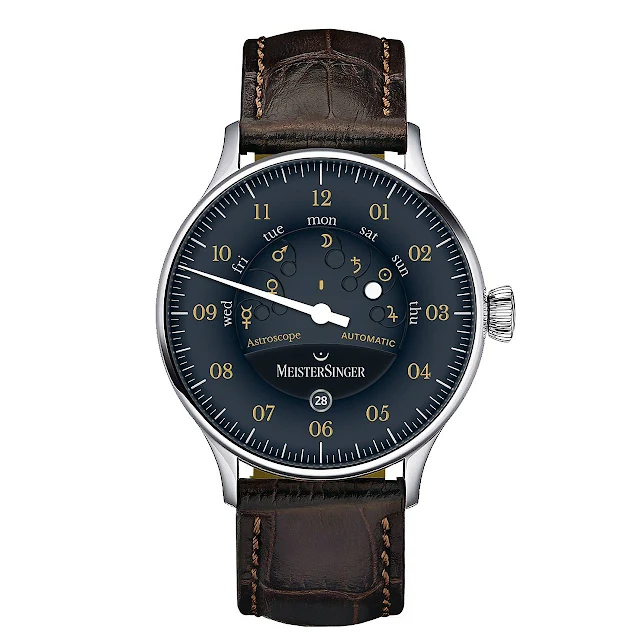On occasion of Inhorgenta 2020, MeisterSinger is presenting its second astronomical watch, the Astroscope. Available with blue or "Old Radium" numerals, the new MeisterSinger Astroscope has a retail price of Euro 1,990.
After the fascinating Lunascope launched in 2018, MeisterSinger is presenting its second astronomical watch, the Astroscope.
The new Astroscope develops an unusual astronomical theme by displaying the days of the week in an unusual way, i.e. by associating each day to the heavenly body that gives it its name.
In fact, the names of the days of the week in most languages are derived from the names of the classical planets in Hellenistic astrology, which were in turn brought from Mesopotomia.
In the 4th century, the Emperor Constantine the Great grafted this astrological system onto the Roman calendar, imposing the following sequence and names to the days of the week:
Dies Solis (Sun) ☉
Dies Lunae (Moon) ☽
Dies Martis (Mars) ♂
Dies Mercurii (Mercury) ☿
Dies Jovis (Jupiter) ♃
Dies Veneris (Venus) ♀
Dies Saturni (Saturn) ♄
This new system spread throughout the Roman Empire and was adopted, with some modifications, throughout most of western Europe: in the Germanic languages, such as Old English, the names of four of the Roman gods were converted into those of the corresponding Germanic gods.
With these celestial bodies and their classical symbols, the Astroscope shows the days of the week not in a linear or radial fashion but wandering back and forth in a constellation that only occurs every ten to twelve years in the southern night sky of the northern hemisphere. Such rare event will recur again in July 2020, when all the celestial bodies of the weekdays - Sun excluded - will be visible at the same time.
The Astroscope stylizes this formation on its dial; a bright dot appears on Monday at about 12 o’clock at the Moon symbol and the next day to the right at the Mars symbol. On Wednesday it appears next to Mercury at about 9 o’clock; on Thursday next to Jupiter at 3 o’clock, and so on.
The watch comes with a brochure that, together with an overview of the historical background, explains the wandering point of the day. The dot appearing next to the day of the week only apparently jumps back and forth. In reality, under the dial a large weekday disk with a number of bright dots on it moves from one day to the next moving in a circle.
Featuring a black dial against which the single hand clearly stands out, the Astroscope is available with blue or "Old Radium" numerals.
Housed in a 40 mm stainless steel case with a 6-screwed exhibition back, the Sellita SW 220 automatic movement beats at a frequency of 4 Hz (28,800 vibrations per hour) and offers a power reserve of 38 hours. The watch is water resistant to 5 bar (50 metres / 165 feet).
Completed by a matching leather strap, the new MeisterSinger Astroscope has a retail price of Euro 1,990. meistersinger.com
The new Astroscope develops an unusual astronomical theme by displaying the days of the week in an unusual way, i.e. by associating each day to the heavenly body that gives it its name.
In fact, the names of the days of the week in most languages are derived from the names of the classical planets in Hellenistic astrology, which were in turn brought from Mesopotomia.
In the 4th century, the Emperor Constantine the Great grafted this astrological system onto the Roman calendar, imposing the following sequence and names to the days of the week:
Dies Solis (Sun) ☉
Dies Lunae (Moon) ☽
Dies Martis (Mars) ♂
Dies Mercurii (Mercury) ☿
Dies Jovis (Jupiter) ♃
Dies Veneris (Venus) ♀
Dies Saturni (Saturn) ♄
This new system spread throughout the Roman Empire and was adopted, with some modifications, throughout most of western Europe: in the Germanic languages, such as Old English, the names of four of the Roman gods were converted into those of the corresponding Germanic gods.
With these celestial bodies and their classical symbols, the Astroscope shows the days of the week not in a linear or radial fashion but wandering back and forth in a constellation that only occurs every ten to twelve years in the southern night sky of the northern hemisphere. Such rare event will recur again in July 2020, when all the celestial bodies of the weekdays - Sun excluded - will be visible at the same time.
The Astroscope stylizes this formation on its dial; a bright dot appears on Monday at about 12 o’clock at the Moon symbol and the next day to the right at the Mars symbol. On Wednesday it appears next to Mercury at about 9 o’clock; on Thursday next to Jupiter at 3 o’clock, and so on.
The watch comes with a brochure that, together with an overview of the historical background, explains the wandering point of the day. The dot appearing next to the day of the week only apparently jumps back and forth. In reality, under the dial a large weekday disk with a number of bright dots on it moves from one day to the next moving in a circle.
Featuring a black dial against which the single hand clearly stands out, the Astroscope is available with blue or "Old Radium" numerals.
Housed in a 40 mm stainless steel case with a 6-screwed exhibition back, the Sellita SW 220 automatic movement beats at a frequency of 4 Hz (28,800 vibrations per hour) and offers a power reserve of 38 hours. The watch is water resistant to 5 bar (50 metres / 165 feet).
Completed by a matching leather strap, the new MeisterSinger Astroscope has a retail price of Euro 1,990. meistersinger.com

















This brand is very creative. They have just one hand but they always find something new.
ReplyDelete